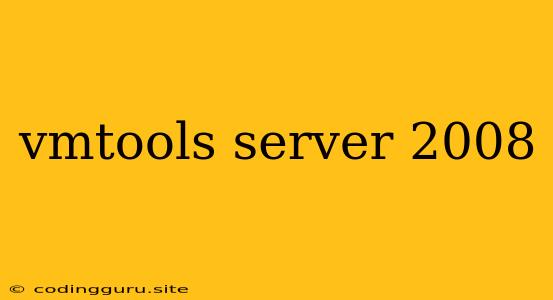VM Tools for Server 2008: A Guide to Enhanced Performance
VMware Tools is a critical suite of utilities designed to enhance the performance and functionality of virtual machines (VMs) running on VMware's hypervisor platform. Specifically, for Server 2008, these tools play a crucial role in streamlining various aspects of your virtualized environment.
Why are VM Tools Important for Server 2008?
- Improved Guest Operating System (OS) Integration: VM Tools enable a seamless integration between the Server 2008 guest OS and the VMware hypervisor. This means smoother performance, enhanced mouse and keyboard responsiveness, and accurate time synchronization.
- Enhanced Guest OS Management: VM Tools empower you to manage your Server 2008 guest OS directly from your VMware management console. This includes essential tasks like starting, stopping, and resetting VMs, as well as managing snapshots and guest OS updates.
- Optimized Resource Utilization: By facilitating proper communication between the Server 2008 guest OS and the hypervisor, VM Tools enable optimal allocation of resources, such as CPU, memory, and storage, maximizing performance.
- Support for Enhanced Features: VM Tools unlock various advanced features within your Server 2008 VMs, including:
- Shared Folders: Allow you to conveniently share files between your host and guest operating systems.
- Drag and Drop Functionality: Enables effortless file transfer between the host and guest OS.
- Improved Graphics: Enhance the visual experience within your Server 2008 guest OS, supporting higher resolutions and improved rendering.
Installing VM Tools in Server 2008
- Accessing the VM Tools ISO: The VM Tools ISO file is typically available within the VMware management console. Locate the VM you wish to install VM Tools on and select the "Settings" or "Virtual Hardware" tab. Look for the VM Tools option, which will provide access to the ISO file.
- Mounting the ISO: Once you have located the VM Tools ISO, mount it within your Server 2008 guest OS. Depending on your Server 2008 version, you can either manually mount the ISO or use a virtual CD/DVD drive.
- Running the Installation: After mounting the ISO, navigate to the mounted drive in your Server 2008 guest OS. Run the setup.exe file to initiate the VM Tools installation process.
- Completing the Installation: Follow the prompts and instructions provided by the installation wizard to complete the VM Tools installation.
Troubleshooting VM Tools Installation
Occasionally, you might encounter issues during VM Tools installation. Some common problems and solutions include:
- Installation Failure: If the installation fails, ensure that your Server 2008 guest OS has the necessary prerequisites, such as the .NET Framework, and that you have sufficient permissions to install the software.
- Missing Features: If certain VM Tools features are missing, check your VMware management console settings for the VM to ensure that they are enabled.
- Incompatibility Issues: If your Server 2008 guest OS version is incompatible with the VM Tools version, refer to VMware's documentation for compatibility details and download the appropriate VM Tools version.
How to Verify VM Tools Installation
After installing VM Tools, it's crucial to verify that the installation was successful:
- Check the VMware Management Console: Examine the VM's settings in your VMware management console. Look for the "VM Tools" section to confirm that the tools are installed and running.
- Check the Guest OS: Within your Server 2008 guest OS, you can verify that the VM Tools are installed by looking for the VMware Tools icon in the system tray.
Tips for Optimal Performance with VM Tools in Server 2008
- Regularly Update VM Tools: Keep your VM Tools up to date to ensure compatibility with new features and bug fixes.
- Optimize VM Resources: Configure the memory, CPU, and storage resources of your Server 2008 guest OS to optimize performance.
- Utilize Shared Folders: Leverage the shared folder feature to efficiently share files between your host and guest operating systems.
- Monitor VM Health: Use VMware tools to monitor key performance indicators of your Server 2008 VMs, such as CPU utilization, memory usage, and disk I/O.
- Keep Guest OS Updated: Ensure that your Server 2008 guest OS is patched with the latest updates to enhance stability and security.
Conclusion:
VM Tools are essential for maximizing the performance, manageability, and functionality of Server 2008 VMs on the VMware platform. By ensuring proper installation, troubleshooting issues, and utilizing the tools effectively, you can leverage the full potential of your virtualized environment, improving resource utilization, guest OS integration, and overall efficiency.
